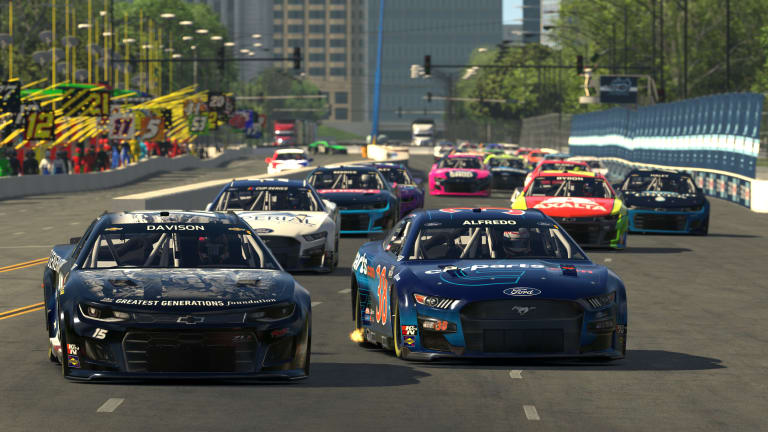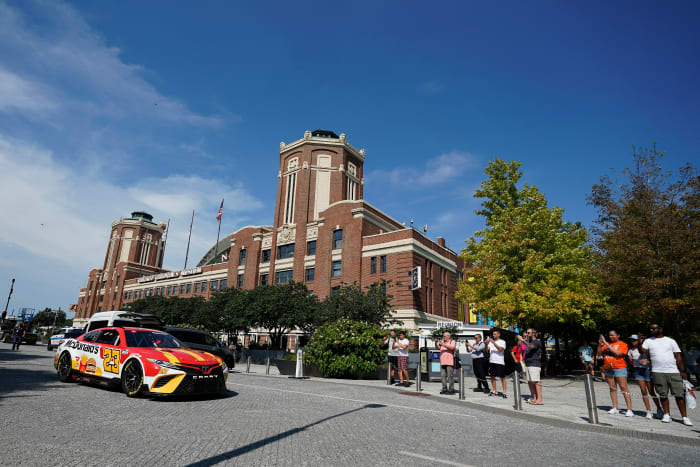
Chicago street course race marks a monumental step for the future of NASCAR
On a warm and sunny Tuesday afternoon in downtown Chicago, the race cars of Bubba Wallace, Ross Chastain and Chase Briscoe sat idly next to a stage occupied by NASCAR and City of Chicago officials.
Then came a situation that literally brought the cars to life. After several weeks of rumors, NASCAR Senior Vice President Ben Kennedy formally announced that the NASCAR Cup Series will take to the streets of downtown Chicago next July for the first-ever event held on a street course in what will be the series’ 75th anniversary.
MONUMENTAL. BOLD. INNOVATIVE. UNPRECEDENTED. ICONIC.
Those words were used repeatedly throughout the afternoon and are a refreshing change of pace for a series that for far too long was reluctant to make changes to a schedule that had become stagnant.
But over the past couple of years, NASCAR executives haven’t shied away from taking major swings when it comes to the schedule. They’ve added more road courses, thrown dirt on Bristol and staged a race inside the iconic Los Angeles Coliseum.
And now the latest change, a 12-turn, 2.2-mile street course that will showcase the iconic Chicago skyline along with Lake Shore Drive, Michigan Avenue, Buckingham Fountain and Grant Park just before the 4th of July next year.
Kennedy said of all of NASCAR's schedule changes over the past couple of years, this was their boldest, calling it the most anticipated event of the season and one of the biggest sport events in our country in 2023.
As a lifelong Chicago-area resident, it’s a day that I could never have imagined when I started following NASCAR in the late 90s. I first became interested as Jeff Gordon and the Rainbow Warriors splashed across my TV screen as I religiously watched ESPN’s SportsCenter at the same time while eating my Rice Krispies every morning.
I really became hooked, though, when I attended my first race in 1999 at Michigan International Speedway.
With an aging fan base and lagging numbers in attendance and ratings compared to the boom of the early 2000s, NASCAR needs to continue to make these types of bold changes to ensure the future success of the sport.
A first-ever street course race in the third-largest city in the country is another step in that direction.
“Being in this city, bringing NASCAR to this demographic, we talk about how representation matters, and I think exposing this sport to this area, downtown, with so much to do around while the race is going on is super important,” said Wallace, driver of the No. 23XI Racing Toyota co-owned by Chicago Bulls legend Michael Jordan.
(Unfortunately, MJ wasn't on hand to add even more spectacular panache to Tuesday's spectacle.)
Added Wallace, “You're going to get that next Bubba Wallace that's sitting in the stands like I was when I was nine years old to be like, 'Hey, I want to do this one day, but I want to be better,' and I'm going to tell them 'Good luck.'”

Fans were revved up when Bubba Wallace took a 'victory lap' around the city after Tuesday's announcement. Photo by Patrick McDermott/Getty Images.
Indeed, that next Bubba Wallace he mentioned may have been listening to him speak those words, as a group from the Boys & Girls Club was in attendance and grew wide-eyed as they peeked inside Wallace’s No. 23 machine. Their enthusiasm and excitement were palpable, and that’s before they gave the command for Wallace to fire the engine and cheered with excitement as it roared to life.
Most fans will tell you that they became hooked when they attended their first race, but the key in today’s world is finding new and innovative ways to provide that initial exposure.
“The opportunity to bring something so unique as NASCAR to the City of Chicago, and I think it's going to be one of the most iconic race courses maybe ever, and introduce a whole new fan base to what NASCAR is about in the City of Chicago, we couldn't pass up that opportunity,” Chicago Mayor Lori Lightfoot said.
“This is the tip of the iceberg, and I think the excitement is now going to be off the charts, and people are really going to be looking forward to July of 2023 when the cars hit the streets here,” Lightfoot added.
It does break my race-loving heart that the addition of the street course in Chicago comes at the expense of Road America, as Kennedy confirmed the Cup Series will not return to the scenic 4.048-mile road course in Elkhart Lake, Wisconsin next year. But that’s a story for another day.
What will the racing product look like on a narrow, tight street course? What will be the financial impact to both the city and local businesses such as hotels and restaurants, as well as the city's infrastructure? And how will all the logistics work for an event unlike anything seen in the history of NASCAR?
Let’s not forget that Chicago is no stranger to holding big events downtown, particularly around Grant Park, on a regular basis.
“We know how to do this,” Lightfoot said of any concerns. “We'll be working hand-in-glove with NASCAR to make sure that the experience is safe, but also incredibly enjoyable for the fans. I'm looking forward to showcasing our fantastic city on a global stage. We're going to do everything we can to make sure that this race is a love letter to the city of Chicago.”
That Lightfoot mentioned the safety element of the experience is noteworthy. Chicago has been awash in significant increases in crime over the last few years. The Windy City had nearly 800 murders in 2021 and has had over 350 thus far in 2022.
Shootings and gun confiscations are through the roof, as are carjackings (over 1,800 last year and already over 1,200 this year), even with additional state and federal law enforcement resources having been added to assist the city's own beleaguered police force.
But there's also one very big question that comes from a racing and attendance perspective.
Will the fans support a race on the streets of Chicago after failing to support races at the 1.5-mile Chicagoland Speedway, located approximately 50 miles southwest of the new street course layout? The track in Joliet, Ill., opened in 2001 to packed grandstands in the heat of July, but attendance drastically decreased, even as the race weekend moved to the cooler month of September and kicked off the NASCAR playoffs for seven consecutive seasons (2011 - 2017). NASCAR ran two more races at the track, in 2018 and 2019, but it has not returned to the schedule since.
It’s no secret that many questions remain and there is a ton of work to be done over the next 12 months to ensure this event is deemed a success. But that, too, is a story for another day.
“There's a lot of unknowns, and if you've been following my journey for the last little bit, I've always said the unknowns is what excites me," Wallace said. ”I don't know what to expect going into this deal. I know that these guys have a lot of work to do and the city does too to get it ready. It's exciting.”
Like Wallace, I’m excited for the unknowns. And I give credit to NASCAR and the City of Chicago for taking the risk. So after returning from the press shindig and in true Windy City fashion, I'll celebrate what's to hopefully come by having a shot of Malort and a slice of deep dish from Pequods.
As Wallace said: “The biggest thing that I was always asked from my dad growing up when we were racing was "Are you having fun?’ And this has fun written all over it.”
